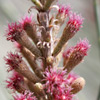Casuarina cunninghamiana is an attractive evergreen tree that grows to a height of 15-35 meters tall. It is native to Australia from New South Wales through Queensland into the Northern Territory. This species was named in 1848 after the botanist Alan
Cunningham (1791-1839).
The trunk of Casuarina cunninghamiana is usually erect, with dense rough bark with a dark grey color, with slight furrows that expose the newly forming pale brown bark. The tree has delicate, slender ultimate branches making the tree look more like a wispy conifer. The foliage consists of deciduous, jointed needle-like branchlets known as cladodes. Though the cladodes are not true leaves, they contain chlorophyll and serve the plants photosynthetic requirement. The cladodes are distinctly ribbed along their length and the true leaf tips or teeth, which are barely visible to the naked eye, encircle the cladodes at regular intervals, 4 to 8mm apart. The rings of leaf teeth at these joints are in whorls of 8-10 though usually 9. Often cladodes are shed after 2 or 3 seasons, particularly those that terminate with male flower spikes. Young trees typically have a pyramidal crown with ascending branches; the crown becomes more open with maturity.
The tree superficially looks like a conifer but belongs to the Dicots. This species is dioecious bearing male and female flowers on different trees. Flowering occurs during spring. The male flower spikes are a rusty colour, 3 to 5 centimetres in length, and terminate on the end of branchlets. Female flowers are small, rich scarlet in color and arranged alternately around a short stalk (1cm in length.) Flowers are grouped in 6-8, forming cones once fertilised, with each ovary containing 2 ovules. They are pollinated by the wind. The fruits superficially resembling a conifer cone made up of numerous carpels each containing a single seed with a small wing. They are usually 1 to 1.5 cm in length and 6-10 mm in diameter, and green-brown in color ripen in the autumn. Pale-bronze winged seed, 3–4 mm in length, are shed at maturity via longitudinal slits arranged around the fruit.
River She-oak typically occurs in its original range in pure stands in sunny locations along freshwater streams and rivers, extending to adjacent valley flats and rarely hillsides at elevations of 0–1000 m. It is widely recognized as an important tree for stabilizing riverbanks and for soil erosion prevention accepting wet and dry soils. It commonly becomes infected with the symbiotic actinomycete Frankia, thereby forming root nodules which are the site of N2 fixation. Inoculation can be accomplished by applying an aqueous suspension of crushed root nodules to young seedlings in containers or nursery beds.
The species is readily propagated from seed but can also be vegetatively propagated by rooting young softwood cuttings using an IBA hormone treatment. Protection from grazing animals, rabbits and hares is important in young plantings. The plants are very tolerant of windswept locations, and are widely planted as windbreaks. It tolerates moderate droughts, periodic waterlogging, acidic to moderately alkaline soils, moderate salinity, and even occasional sub-freezing temperatures.
Because of its wide adaptability Casuarina cunninghamianat has been introduced for reforestation throughout the world in Africa, Asia, and in Central, South, and North America, and throughout Australia, New Zealand, and elsewhere for the purpose of soil stabilization. The foliage is quite palatable to stock. It is also an excellent source of fire-wood. The wood is very easily split, can be burned either green or dried, and bums slowly leaving little ash.
Casuarina cunninghamiana wood is moderately durable and very strong once dried. The turning and finishing qualities are excellent with a close straight grain of moderately fine texture. It polishes well to a natural deep luster. The wood is moderately hard and can be difficult to work. Care must be taken when gluing and the timber usually requires drilling prior to nailing.
Traditionally river she-oak had many uses for the aboriginal people. The wood from either the stems or roots was utilized for fashioning boomerangs, shields, and spear-throwers. Gum scraped from under the bark acted as a sealant for canoes and various compounds were extracted for medicinal purposes.
Casuarina was once regarded as the sole genus in its family Casuarinaceae, but has been lateler split into three genera.
Written by Amram Eshel






